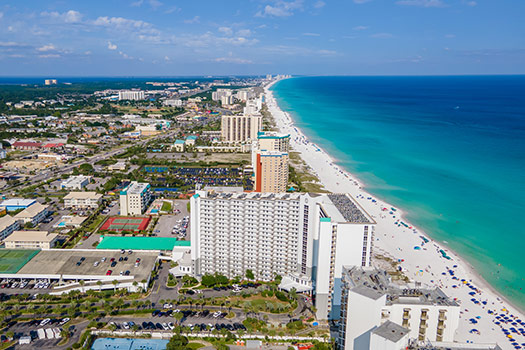Spring/Summer 2023 Trends Update
As the traditional summer season kicks into high gear, it's time to take a closer look at the latest trends and occupancy rates affecting the short-term rental market in Destin. Understanding these key insights will helps us make informed decisions to attract more guests and maximize your revenue.
Booking paces have been picking up over the past couple of weeks. Short-lead time vacation planning has become the primary trend in 2023. Following increasing economic trends, which began in Q3 of 2022, combined with the debt-ceiling extension fears which was a concern to us as nearly 25% of the population in our key feeder markets is directly influenced by government payroll.
This year, occupancy on the books for the summer is much lower than the previous two years and, in some markets, is even lower than pre-pandemic. Often, we search for one primary explanation for year-over-year decreases, such as a global pandemic during 2020, but this year, many small changes are adding up to a significant shift. While occupancy is pacing lower than last year, not all hope is lost! Booking windows have shortened and many reservations are being made within 30 days of arrival, so there is still time to turn things around!
Florida Adjusted Paid Occupancy: A Shift in the Market
The Florida Panhandle's Adjusted Paid Occupancy rates for the summer season are currently below both 2021 and 2022 levels. This trend is reflective of a market that is still adjusting after a significant drop in occupancy from 2021 to 2022. While this summer is pacing behind last year, it's important to note that the decreases vary across different markets. Areas such as 30A, Cape San Blas, and Miramar Beach are experiencing the largest decreases of around 9% from the previous year.
Pacing Behind 2019: Identifying the Challenges
In several markets, including 30A, Destin, Miramar Beach, Panama City Beach, Okaloosa Island, and Perdido Key, occupancy rates are also pacing behind 2019 levels. However, there is a silver lining. Cape San Blas and Pensacola Beach are pacing on par with or even slightly ahead of 2019 occupancy rates. This insight suggests that the potential for attracting guests is still there, albeit with some adjustments to your marketing strategies and property offerings.
The Role of Booking Windows: An Increasing Gap
Booking windows play a significant role in occupancy rates, as demonstrated by the widening gap between last year's occupancy and the current pace. Just three months ago, 30A's adjusted paid occupancy rate was only 4% behind the previous year. However, as of May, the gap has expanded to 9%, highlighting the impact of medium booking windows. Although occupancy is currently pacing behind, there's still time for summer bookings to pick up. Historical data shows that a substantial portion of reservations—51%—were made within 60 days of arrival, with 31% occurring within just 30 days of booking.
Unveiling Booking Sources: Airbnb Takes the Lead
When examining Summer 2022 reservations based on booking sources and windows, Airbnb emerges as a prominent player. Reservations made through Airbnb experienced an increase as a percentage of check-ins, particularly within a 30-day booking window. While 15% of all summer reservations were made on Airbnb, that percentage surged to 22% for bookings made within 30 days of arrival. Direct bookings accounted for 38% of all reservations, while Vrbo secured 41%. In the 30-day window, direct bookings decreased to 31%, with Vrbo dipping by only 1% to 40%. These figures indicate that last-minute, affordable reservations are more likely to be made through online travel agencies (OTAs) like Airbnb and Vrbo.
Capitalizing on the Last-Minute Market: Optimization and Marketing
It's crucial to understand that Airbnb is not solely responsible for driving guests toward lower-priced stays; it merely attracts a particular audience. To tap into the potential of last-minute reservations for summer stays, property managers should optimize their inventory for the platforms they advertise on, emphasizing their marketing strategies. As consumers become more price-sensitive and supply increases, it's vital to be aware of pricing in your market and make adjustments accordingly. However, reducing rates alone may negatively impact revenue, so a well-executed marketing strategy and effective revenue management are essential for securing those last-minute summer reservations.
Conclusion:
With occupancy rates in the Florida Panhandle pacing behind previous years, vacation rental owners need to adapt to the evolving market dynamics. As your rental management company, we on top of these trends and we are showing a higher occupancy and REVPAR that others in resort, but also our area. By capitalizing on last-minute bookings, optimizing property listings, and implementing effective marketing strategies, you can stand out from the competition and attract price-conscious travelers. While challenges exist, the potential for a successful summer rental season remains high.








